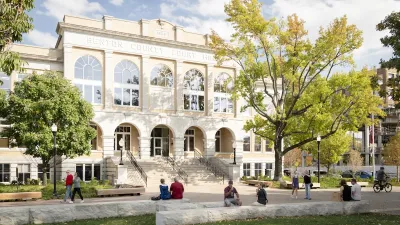In the first of two installments, the Boston Globe delves into the ever-changing built environment of Shanghai, one of China's fastest growing cities.
"Stand on the concrete promenade of the Bund , a once-chaotic river wharf at the very center of this city, and spin: The horizon towers for 360 degrees. Neon streaks in blue, red, orange, and green. Silver apartment buildings merge at the edge of sight. Turn after turn, the fantasy of the Oriental Pearl Tower and the certainty of the 88-story Jinmao Tower punctuate new Pudong, a district sprung from swamp and farmland.
If the goal were simply reinventing the physical face of a place, then the game in Shanghai has been won: In the blur of a dozen years, hundreds of acres of low, lane-linked neighborhoods have surrendered to skyscrapers. So many people in this city of 18 million have scrambled from their torn-down homes and traditions into dizzying new terrain of 2,000 towers and more. Individual lives react again as Shanghai leads China's charge from closed communism toward free-market modernity, stopping who knows where. Politicians and planners cite statistics and strategies to debate whether Shanghai, and China behind it, will conquer or crash."
FULL STORY: New spin on Shanghai

Americans May Be Stuck — But Why?
Americans are moving a lot less than they once did, and that is a problem. While Yoni Applebaum, in his highly-publicized article Stuck, gets the reasons badly wrong, it's still important to ask: why are we moving so much less than before?

Using Old Oil and Gas Wells for Green Energy Storage
Penn State researchers have found that repurposing abandoned oil and gas wells for geothermal-assisted compressed-air energy storage can boost efficiency, reduce environmental risks, and support clean energy and job transitions.

Placekeeping: Setting a New Precedent for City Planners
How a preservation-based approach to redevelopment and urban design can prevent displacement and honor legacy communities.

San Francisco’s Muni Ridership Grew in 2024
The system saw its highest ridership since before the Covid-19 pandemic, but faces a severe budget shortage in the coming year.

Colorado Lawmakers Move to Protect BRT Funding
In the face of potential federal funding cuts, CDOT leaders reasserted their commitment to planned bus rapid transit projects.

Safe Streets Funding in Jeopardy
The Trump administration is specifically targeting bike infrastructure and other road safety projects in its funding cuts.
Urban Design for Planners 1: Software Tools
This six-course series explores essential urban design concepts using open source software and equips planners with the tools they need to participate fully in the urban design process.
Planning for Universal Design
Learn the tools for implementing Universal Design in planning regulations.
Heyer Gruel & Associates PA
City of Moreno Valley
Institute for Housing and Urban Development Studies (IHS)
City of Grandview
Harvard GSD Executive Education
Salt Lake City
NYU Wagner Graduate School of Public Service
City of Cambridge, Maryland


























